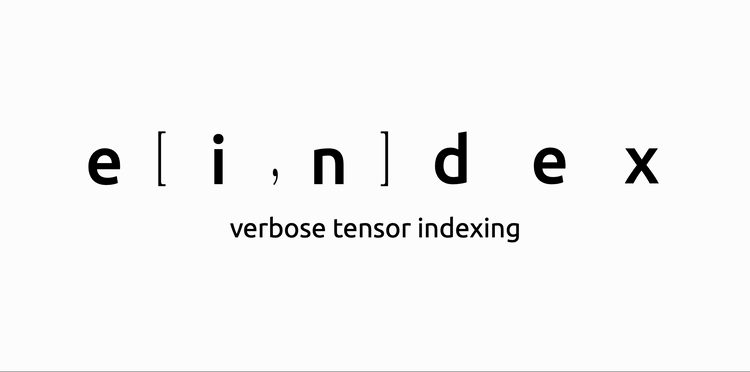Concept of multidimensional indexing for tensors
Plain numpy
def kmeans(init_centers, X, n_iterations: int):
n_clusters, n_dim = init_centers.shape
n_onservations, n_dim = X.shape
centers = init_centers.copy()
for _ in range(n_iterations):
d = cdist(centers, X)
clusters = np.argmin(d, axis=0)
new_centers_sum = np.zeros_like(centers)
indices_dim = np.arange(n_dim)[None, :]
np.add.at(new_centers_sum, (clusters[:, None], indices_dim), X)
cluster_counts = np.bincount(clusters, minlength=n_clusters)
centers = new_centers_sum / cluster_counts[:, None]
return centersWith eindex
def kmeans_eindex(init_centers, X, n_iterations: int):
centers = init_centers
for _ in range(n_iterations):
d = cdist(centers, X)
clusters = EX.argmin(d, 'cluster i -> [cluster] i')
centers = EX.scatter(X, clusters, 'i c, [cluster] i -> cluster c',
agg='mean', cluster=len(centers))
return centers- Form a helpful 'language' to think about indexing and index-related operations. Tools shape minds
- Cover most common cases of multidimensional indexing that are hard to implement using the standard API
- Approach should be applicable to most common tensor frameworks, autograd should work out-of-the-box
- Aim for readable and reliable code
- Allow simple adoption in existing codebases
- Implementation should base on fairly common tensor operations. No custom kernels allowed.
- Complexity should be visible: execution plan for every operation should form a static graph. Structure of the graph depends on the pattern, but not on tensor arguments.
Non-goals: there is no goal to develop 'the shortest notation' or 'the most advanced/comprehensive tool for indexing' or 'cover as many operations as possible' or 'completely replace default indexing'.
Follow tutorial first to learn about all operations provided.
Click to unfold
Let's say you have pairs of images and captions, and you want to take closest embedding from image for every token:
score = einsum(images_bhwc, sentences_btc, 'b h w c, b token c -> b h w token')
closest_index = argmax(score, 'b h w token -> [h, w] b token')
closest_emb = gather(images_bhwc, closest_index, 'b h w c, [h, w] b token -> b token c')To adjust this example for video not image, replace 'h w' to 'h w t'. Yes, that simple.
[most_likely_words] = argmax(prob_tbc, 't b w -> [w] t b')
[top_words] = argsort(prob_tbc, 't b w -> [w] t b order')[..., -3:]# without batch (single graph)
gatherscatter(embeddings, edges, 'vin c, [vin, vout] edge -> vout')
# with batch (multile graphs)
gatherscatter(embeddings, edges, 'b vin c, [b, vin, vout] edge -> b vout')If we're speaking about trainable abspos, it can be just saved as emb_hwc and added every time to a batch.
There is no need for indexing.
But it can be very helpful for complex scenarios: let's take T5-relpos as an example, when a bias is added to every attention logit before softmax-ing.
That's simple to implement for 1d, and much harder for 2d/3d. Let's implement T5-relpos in 2d with eindex:
N = None
pos # [I, J] i j
pos1 = pos[:, :, :, N, N]
pos2 = pos[:, N, N, :, :]
xy_diff = (pos1 - pos2) % image_side # we make shifts positive by wrapping
attention_bias = gather(biases, xy_diff, 'i j head , [i, j] i1 j1 i2 j2 -> i1 j1 i2 j2 head')Note that we use 2d-relative position (shift in x and y), while most implementations just use sequence shift.
In a similar way we could produce vector-shift attention (another common version of relpos):
vector_shift = gather(vectors, xy_diff, 'i j head c, [i, j] i1 j1 i2 j2 -> i1 j1 i2 j2 head c')Repo provides two implementation:
-
array api standard. This implementation is based on a standard that multiple frameworks pre-agreed to follow. Implementation uses only API from standard, so all available operations support all frameworks that follow the standard.
At some point this should become the one and the only implementation.
Here is the catch: current support of array api standard is poor, that's why the second implementation exists
-
numpy implementation
This independent implementation works right now.
Numpy implementation is great to test things out, and is handy for a number of non-DL applications as well.
API looks solid, but breaking changes are still possible, so lock the version in your projects (e.g. eindex==0.1.0)
Other projects you likely want to look at:
- tullio by Michael Abbott (@mcabbott) provides Julia macros with a high level of flexibility. Resulting operations are then compiled.
- torchdim by Zachary DeVito (@zdevito) introduces "dimension objects", which in particular allow convenient multi-dim indexing
- einindex is an einops-inspired prototype by Jonathan Malmaud (@malmaud) to develop multi-dim indexing notation.
(Also, that's why this package isn't called
einindex)
We welcome the following contributions:
- next time you deal with multidimensional indexing, do this with eindex
Worked? → great - let us know; didn't work or unclear how to implement → post in discussions - if you feel you're already fluent in eindex, help others
- guides/tutorials/video-guides are very welcome, and will be linked
- If you want to translate tutorial to other language and post it somewhere - welcome
Use discussions at github for this project https://github.com/arogozhnikov/eindex/discussions
